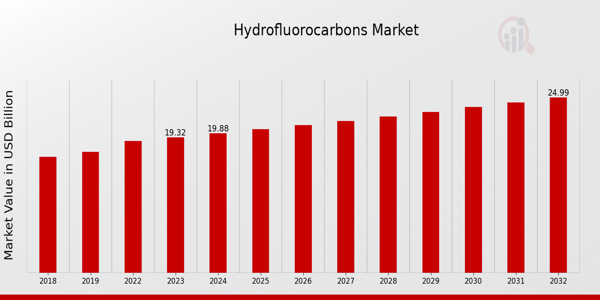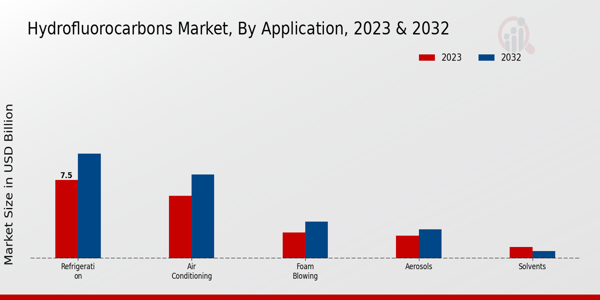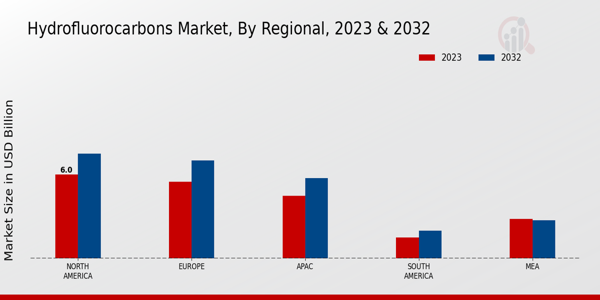Global Hydrofluorocarbons Market Overview
The Hydrofluorocarbons Market Size was estimated at 20.46 (USD Billion) in 2024.The Hydrofluorocarbons Industry Market is expected to grow from 21.06 (USD Billion) in 2025 to 27.29 (USD Billion) by 2034. The Hydrofluorocarbons Market CAGR (growth rate) is expected to be around 2.9% during the forecast period (2025 - 2034).
Key Hydrofluorocarbons Market Trends Highlighted
The growth and development of the hydrofluorocarbons market are impacted by a number of important market drivers. The increasing need for cooling solutions in both residential and commercial settings is driving up demand for HFCs in refrigeration and air conditioning systems. HFCs are frequently thought of as transitional solutions, and the phase-out of ozone-depleting compounds has also raised attention to alternatives. Companies are being forced to look for low-GWP (warming potential) alternatives due to strict restrictions surrounding climate change and its effects on the environment. This is generating a dynamic market landscape. The development of sophisticated low-GWP refrigerants is one of the many potential to be investigated in this dynamic field. By developing sustainable solutions that adhere to legal requirements, businesses that invest in R&D can gain market share. The Hydrofluorocarbons Market is influenced by various key market drivers that contribute to its growth and development. The demand for HFCs in refrigeration and air conditioning systems continues to rise, driven by the growing need for cooling solutions in both residential and commercial spaces.Additionally, the phase-out of ozone-depleting substances has led to an increased focus on alternatives, with HFCs often being regarded as transitional solutions. Stringent regulations surrounding climate change and environmental impact are pushing companies to seek low-GWP (warming potential) alternatives, thus creating a dynamic market landscape.There are various opportunities to be explored in this evolving market, such as the development of advanced low-GWP refrigerants. Companies investing in research and development can capture market share by innovating sustainable solutions that comply with regulatory standards.Moreover, partnerships between key industry players and investment in emerging economies present pathways for growth. The increasing adoption of environmentally friendly technologies in developing regions can enhance market prospects further.Trends in recent times indicate a shift toward more sustainable practices as industries search for alternatives to traditional HFCs that align with climate agreements.The industry is also witnessing an influx of technological advancements, promoting eco-friendly refrigeration methods. In particular, natural refrigerants and blended solutions are gaining traction. Additionally, the trend of government incentives for green technologies is fostering an increase in market participation.As environmental concerns grow, businesses are recognizing the advantages of adopting sustainable practices, further reshaping the landscape of the Hydrofluorocarbons Market.

Source: Primary Research, Secondary Research, MRFR Database and Analyst Review
Hydrofluorocarbons Market Drivers
Increasing Demand for Refrigerants
The Hydrofluorocarbons Market IndustryMarket is witnessing a significant surge in demand for refrigerants, which is one of the foremost drivers for market growth. Hydrofluorocarbons (HFCs) are widely utilized in refrigeration and air conditioning systems due to their effective cooling properties and low toxicity.As temperatures rise and the need for climate control systems increases, the demand for HFCs in residential, commercial, and industrial applications continues to grow.Technological advancements in HVAC systems further catalyze this demand as manufacturers transition towards using more efficient refrigerant options to meet energy efficiency standards.Furthermore, the burgeoning food and beverage industry, which relies heavily on refrigeration for storage and transportation, contributes to the increasing consumption of HFCs.Regulatory frameworks aimed at reducing greenhouse gas emissions while potentially limiting certain HFC applications also lead to innovation in developing more sustainable HFC blends.These trends indicate a strong continuing growth projection for the Hydrofluorocarbons Market, establishing it as a critical component in modern manufacturing and comfortable living solutions.
Regulatory Support and Policy Changes
The Hydrofluorocarbons Market IndustryMarket is significantly affected by regulatory measures and policy changes aimed at promoting environmentally friendly practices. Governments and international organizations are creating regulations to phase down the production and consumption of high-global-warming-potential (GWP) HFCs while simultaneously encouraging the use of low-GWP alternatives.This impetus from regulatory bodies drives innovation, pushing manufacturers towards developing new products with better performance and lower environmental impact.Many countries are also providing incentives for adopting greener technologies, producing a favorable environment for growth in the Hydrofluorocarbons Market.
Growing Urban Population and Rising Living Standards
The rapid urbanization and increasing disposable income globally have led to enhanced living standards and demand for advanced cooling solutions.The growing urban population across regions is driving the need for effective air conditioning systems and refrigeration solutions in residential and commercial spaces. This trend is particularly evident in developing countries, where rising temperatures and changing climate patterns necessitate the installation of reliable cooling systems.The Hydrofluorocarbons Market IndustryMarket benefits from this increased reliance on HFCs for ensuring comfort, coupled with the need to comply with new environmental and energy standards. Enhanced living conditions and the demand for high-quality appliances further propel the market forward.
Hydrofluorocarbons Market Segment Insights
Hydrofluorocarbons Market Application Insights
The Hydrofluorocarbons Market is poised for steady growth, particularly within the Application segment, which encompasses various uses such as Refrigeration, Air Conditioning, Foam Blowing, Aerosols, and Solvents.The Refrigeration sector led this segment with a significant contribution, valued at 7.5 USD Billion in 2023 and climbing to 10.0 USD Billion in 2032, demonstrating its importance in both residential and commercial cooling systems.This segment's dominance can be attributed to the heightened demand for refrigerants in food preservation and cold chain logistics, making it a majority holder in the Application domain.Following closely was the Air Conditioning segment, valued at 6.0 USD Billion in 2023 and expected to expand to 8.0 USD Billion in 2032, fueled by the rising temperatures and the need for efficient cooling solutions in various climatic conditions.As more households and businesses upgrade their heating and cooling systems, the role of hydrofluorocarbons in this segment remains significant.Foam Blowing applications, worth 2.5 USD Billion in 2023 and projected to rise to 3.5 USD Billion in 2032, also showcased the importance of hydrofluorocarbons in producing insulation foams, which are critical for energy-efficient constructions and appliances.The Aerosols segment, with a valuation of 2.2 USD Billion in 2023, expanding to 2.8 USD Billion by 2032, reflected growing usage in consumer goods such as personal care and household products.Meanwhile, the Solvents segment appeared to experience a decline, with a valuation of 1.12 USD Billion in 2023 and expected to reduce to 0.7 USD Billion in 2032, likely due to the increasing environmental regulations aimed at reducing solvent-based products due to their VOC emissions.Overall, the Hydrofluorocarbons Market segmentation illustrated how various applications contribute to the industry's growth, driven by an increasing emphasis on energy efficiency, regulatory changes, and shifting consumer preferences toward sustainable practices.The different segments provided unique insights and dynamics within the overall market, showcasing varied growth potentials and challenges as consumer and regulatory demands evolve.

Source: Primary Research, Secondary Research, MRFR Database and Analyst Review
Hydrofluorocarbons Market End Use Industry Insights
The Hydrofluorocarbons Market within the End Use Industry segment showcases its significance by highlighting a wide array of applications. The Residential domain plays a crucial role, focusing on air conditioning and refrigeration, while the Commercial segment significantly contributes through its utilization of HVAC systems and refrigeration units.Furthermore, the Industrial sector relies on hydrofluorocarbons for manufacturing processes and equipment cooling, reflecting its vital role in supporting diverse industries. The Automotive sector is also notable, utilizing hydrofluorocarbons in mobile air conditioning systems, thus ensuring the comfort of drivers and passengers alike.The continuous emphasis on energy efficiency and regulatory shifts towards environmentally friendly refrigerants are key factors in shaping the dynamics of this segment, presenting both opportunities and challenges.As the Hydrofluorocarbons Market evolves, understanding its segmentation will be essential for stakeholders aiming to capitalize on emerging trends and innovations in this industry.
Hydrofluorocarbons Market Type Insights
The Hydrofluorocarbons Market has shown notable activity across various types. Among the diverse range of types within the market, Hydrofluorocarbon-134a holds a major share due to its widespread application in refrigeration and air conditioning, which continues to drive demand.Hydrofluorocarbon-125 also contributes significantly as it is commonly utilized in fire extinguishing systems, highlighting its importance in safety applications. Meanwhile, Hydrofluorocarbon-152a is rising in prominence as a low-warming potential alternative, appealing to environmentally conscious consumers.Hydrofluorocarbon-32 dominates in the residential heat pump and air conditioning sectors primarily because of its efficient thermal performance. These types are critical for various applications, reflecting the market growth facilitated by technological advancements and increasing regulations aimed at reducing environmental impact.The segmentation data illustrates a well-rounded industry poised for development, aligning with sustainability trends and innovative solutions in the broader Hydrofluorocarbons Market industryMarket.
Hydrofluorocarbons Market Regulatory Compliance Insights
The Regulatory Compliance segment of the Hydrofluorocarbons Market is crucial, as it ensures adherence to international and national standards aimed at reducing environmental impacts. The market continues to evolve with regulations like the F-Gas Regulation, which seeks to limit greenhouse gas emissions, playing a significant role in shaping compliance strategies.The Montreal Protocol has also been pivotal in phasing out substances that deplete the ozone layer, leading to a shift in using hydrofluorocarbons as alternatives.Furthermore, National Regulations are tailored to specific regional needs, contributing to the overall compliance landscape and making it a notable driver of market growth.Collectively, these regulatory frameworks form the backbone of the industry's efforts to mitigate climate change and promote sustainable practices in the Hydrofluorocarbons Market industryMarket, highlighting their importance in guiding market dynamics and ensuring responsible usage of these chemicals.This robust compliance environment fosters both challenges and opportunities for stakeholders as they navigate the complexities of new legislation and market demands.
Hydrofluorocarbons Market Regional Insights
In North America, the market held a significant 6.0 USD Billion, projected to rise to 7.5 USD Billion by 2032, establishing it as a major region due to robust industrial applications and regulatory advancements. Europe followed closely with a valuation of 5.5 USD Billion in 2023, expected to grow to 7.0 USD Billion, driven by stringent environmental regulations and a transition toward sustainable practices.The APAC region, valued at 4.5 USD Billion in 2023, is likely to reach 5.75 USD Billion, reflecting its rapid industrialization and rising demand for refrigerants.South America, with a smaller market size of 1.5 USD Billion, is anticipated to grow to 2.0 USD Billion, indicating emerging opportunities partly driven by climate change policies.Meanwhile, the MEA segment, valued at 2.82 USD Billion in 2023, is projected to decline slightly to 2.75 USD Billion by 2032 due to geopolitical challenges and varying regulations affecting market dynamics.Overall, the Hydrofluorocarbons Market statistics revealed regional diversity, with North America and Europe dominating, highlighting distinct growth drivers and challenges across the different markets.

Source: Primary Research, Secondary Research, MRFR Database and Analyst Review
Hydrofluorocarbons Market Key Players and Competitive Insights
The competitive insights of the Hydrofluorocarbons Market unveil a dynamic landscape characterized by the innovative strategies and product offerings of key industry players. The market is undergoing significant transformation due to the regulatory frameworks aimed at phasing out high Warming Potential compounds.This shift has prompted companies to invest in research and development, focusing on eco-friendly alternatives while ensuring compliance with international environmental standards. Additionally, the competition among various manufacturers is intensifying as they strive to expand their market presence and enhance their technological capabilities.Companies are increasingly forming strategic partnerships and collaborations to leverage their strengths and effectively address the evolving needs of end-user industries like refrigeration, air conditioning, and foam manufacturing.Daikin has established a formidable presence in the Hydrofluorocarbons Market, showcasing its strengths through robust technological advancements and an extensive product portfolio.The company's commitment to innovation is evident in its development of high-performance HFCs that cater to diverse applications, ensuring both efficiency and lower environmental impact.Daikin's strong brand reputation and reach allow it to serve a wide array of markets effectively, thus maintaining a competitive edge amidst the increasing scrutiny on greenhouse gas emissions.The company's focus on sustainability and investment in alternative refrigerants further reinforces its position as a leader in the market, enabling it to meet regulatory demands while providing reliable solutions to customers.BASF, a strong player in the Hydrofluorocarbons Market, leverages its extensive expertise in chemical production to offer a comprehensive range of HFC products that comply with stringent environmental regulations.The company's innovative approach to product development and a significant emphasis on sustainability has enabled it to carve out a niche in an increasingly competitive environment. BASF's commitment to reducing its carbon footprint and enhancing energy efficiency positions it favorably within the market.The company's robust research initiatives and creation of alliances facilitate the launch of novel solutions that cater to the growing demand for environmentally friendly refrigerants. Furthermore, BASF's comprehensive distribution network allows it to maintain a strong market presence, providing timely and efficient service to its customers across various sectors.
Key Companies in the Hydrofluorocarbons Market Include
-
Daikin
-
BASF
-
Linde
-
SRF Limited
-
Air Products
-
Solvay
-
Arkema
-
Juhua Group
-
Prasol Chemicals
-
Chemours
-
SABIC
-
Dongyue Group
-
Deepak Nitrite
-
Honeywell
-
Mitsubishi
Hydrofluorocarbons Market IndustryMarket Developments
The Hydrofluorocarbons Market has seen significant recent developments and current affairs highlighting increased regulatory scrutiny and evolving market dynamics. Major companies like Daikin and Honeywell are actively adapting their product portfolios in compliance with stricter climate regulations that target HFCs due to their high warming potential.Meanwhile, BASF and Solvay continue to innovate in developing alternatives to traditional HFCs, striving to maintain competitiveness amid tightening regulations. Additionally, Linde has made strides in expanding its production capabilities to meet surging demand, fueled by a growing emphasis on sustainability.Noteworthy mergers and acquisitions have also characterized the market; for instance, Arkema's acquisition of specific chemical assets enhances its position in the HFC alternatives market.In terms of market valuation, many companies are experiencing growth due to increased demand for HFCs in refrigeration and air conditioning applications, while ongoing transitions to low-GWP alternatives are reshaping strategic priorities across organizations like SABIC and Deepak Nitrite.The financial performance of these companies reflects the pivotal changes occurring within the industry, significantly impacting overall market trends and investment strategies moving forward.
Hydrofluorocarbons Market Segmentation Insights
Hydrofluorocarbons Market Application Outlook
-
Refrigeration
-
Air Conditioning
-
Foam Blowing
-
Aerosols
-
Solvents
Hydrofluorocarbons Market End Use Industry Outlook
-
Residential
-
Commercial
-
Industrial
-
Automotive
Hydrofluorocarbons Market Type Outlook
-
Hydrofluorocarbon-134a
-
Hydrofluorocarbon-125
-
Hydrofluorocarbon-152a
-
Hydrofluorocarbon-32
Hydrofluorocarbons Market Regulatory Compliance Outlook
-
F-Gas Regulation
-
Montreal Protocol
-
National Regulations
Hydrofluorocarbons Market Regional Outlook
-
North America
-
Europe
-
South America
-
Asia Pacific
-
Middle East and Africa
| Report Attribute/Metric |
Details |
| Market Size 2024 |
20.46 (USD Billion) |
| Market Size 2025 |
21.06 (USD Billion) |
| Market Size 2034 |
27.29 (USD Billion) |
| Compound Annual Growth Rate (CAGR) |
2.9% (2025 - 2034) |
| Report Coverage |
Revenue Forecast, Competitive Landscape, Growth Factors, and Trends |
| Base Year |
2024 |
| Market Forecast Period |
2025 - 2034 |
| Historical Data |
2020 - 2024 |
| Market Forecast Units |
USD Billion |
| Key Companies Profiled |
Daikin, BASF, Linde, SRF Limited, Air Products, Solvay, Arkema, Juhua Group, Prasol Chemicals, Chemours, SABIC, Dongyue Group, Deepak Nitrite, Honeywell, Mitsubishi |
| Segments Covered |
Application, End Use Industry, Type, Regulatory Compliance, Regional |
| Key Market Opportunities |
Increasing demand in HVAC systems, Growth in consumer electronics production, Transition to low-GWP alternatives, Expanding refrigerant recovery services, Strong regulations favoring sustainable solutions |
| Key Market Dynamics |
Regulatory changes and bans, Growing refrigeration and AC demand, Alternatives development and adoption, Environmental concerns and awareness, Technological advancements in applications |
| Countries Covered |
North America, Europe, APAC, South America, MEA |
Frequently Asked Questions (FAQ) :
The Hydrofluorocarbons Market is expected to be valued at 27.29 USD Billion by 2034.
The market is projected to have a CAGR of 2.9% from 2025 to 2034.
Refrigeration accounted for the largest value at 7.5 USD Billion in 2023.
The Hydrofluorocarbons Market in North America was valued at 6.0 USD Billion in 2023.
The market size for Air Conditioning applications is expected to reach 8.0 USD Billion by 2032.
The market value for Foam Blowing applications in 2023 was 2.5 USD Billion.
Major players in the Hydrofluorocarbons Market include Daikin, BASF, and Honeywell.
The market size for the MEA region is expected to be 2.75 USD Billion by 2032.
The South American Hydrofluorocarbons Market was valued at 1.5 USD Billion in 2023.
The Solvents segment is projected to decline to 0.7 USD Billion by 2032.

















